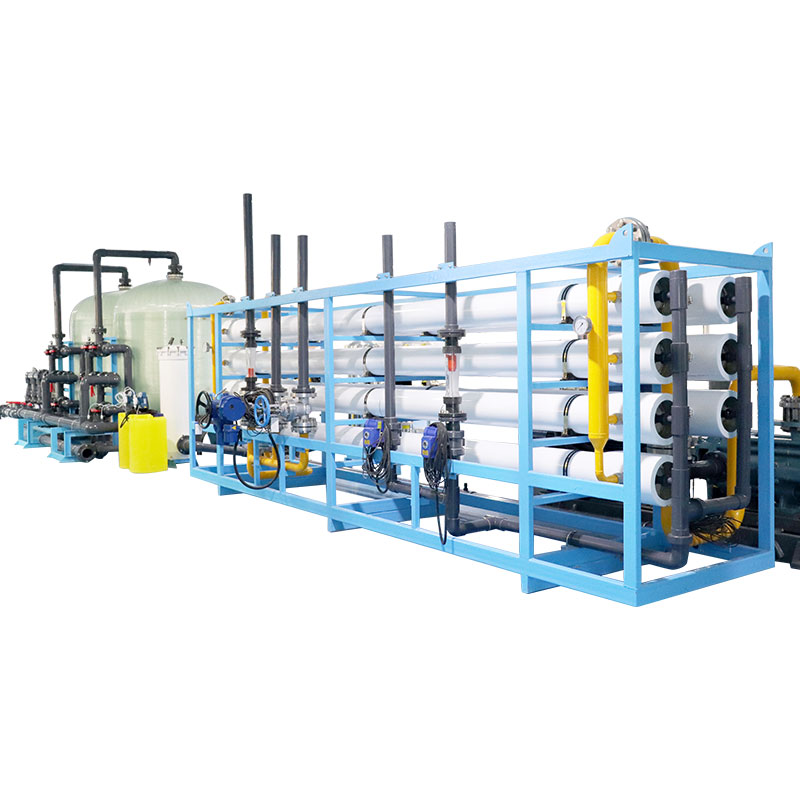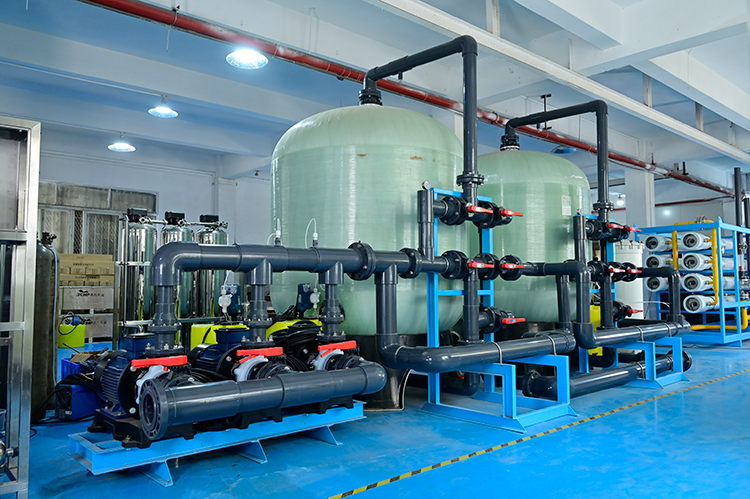What is a reverse osmosis system? How does a reverse osmosis system work?
A reverse osmosis system (RO system) is a multi-stage water treatment process that uses a semi-permeable membrane and pressure to remove contaminants from the water, producing clean drinking water.
In an RO system, pressure forces unfiltered or feed water through a semipermeable membrane, which separates contaminants. In the final filtration stage, through the pressure of the reverse osmosis membrane, water flows from the side with more pollutants to the side with less pollutants. The fresh water produced is called permeate water, and the concentrated water left behind is called wastewater or brine. Reverse osmosis technology is an efficient and energy-saving separation technology. Its working principle relies on the reverse osmosis membrane to separate the solvent and solute in the solution under pressure.

1. Development history
Reverse osmosis technology originated in the 1960s and is a new membrane separation technology. It was initially used by American astronauts to recycle urine into pure water for use, and was later used in the medical community for medical applications such as kidney dialysis (hemodialysis). With the advancement of science and technology and the development of industrialization, reverse osmosis technology has gradually been applied in the field of water treatment, becoming an important means to solve water pollution and provide clean drinking water.
2. Working principle
The working principle of the reverse osmosis system is membrane separation and filtration technology that uses pressure difference as power. The pore size of its reverse osmosis membrane is extremely small, reaching the nanometer level. Only water molecules can pass through, while other macromolecules, ions, bacteria, viruses and other impurities cannot pass through the reverse osmosis membrane. Under a certain pressure, water molecules are forced through the reverse osmosis membrane, while pollutants are left on one side of the membrane, thus achieving water purification and separation. This process does not add any bactericides and chemicals. It is a physical separation purification technology that can ensure the purity and safety of purified water.
3. Application areas
Reverse osmosis systems are widely used in many areas including domestic, commercial and industrial areas. In homes, RO systems are often used to purify tap water and provide clean and healthy drinking water; in commercial places, such as restaurants, coffee shops, etc., RO systems can be used to purify water sources and ensure the quality of food and drinks; in the industrial field, RO systems It can be used for water treatment in the production process to ensure product quality and clean production environment. Reverse osmosis technology has become more and more widely used and has become an important tool to solve water quality problems.

What are the advantages and disadvantages of reverse osmosis systems?
1. Advantages
The advantages of reverse osmosis systems include efficient water purification, no use of chemicals, safety and health, and suitability for a variety of water qualities. The water treated by the RO system has high purity, which can effectively remove harmful substances in the water and provide clean and healthy drinking water. At the same time, the RO system does not require the addition of any chemicals, does not produce secondary pollution, and is environmentally friendly. In addition, the RO system is suitable for a variety of water qualities and can treat water from different sources such as surface water, groundwater, and seawater.
2. Disadvantages
However, reverse osmosis systems also have some disadvantages. First, it produces a lot of wastewater, wastes water resources, and increases the cost and difficulty of treating wastewater. Secondly, the reverse osmosis system requires certain investment costs, including equipment purchase, operation and maintenance, etc., and the cost is relatively high. In addition, since RO systems remove all minerals from water, long-term drinking of RO-treated water may lead to mineral deficiencies, which can adversely affect health.
3. Countermeasures
In order to overcome the shortcomings of reverse osmosis systems, some countermeasures can be taken. For example, reasonably control the frequency of use of the RO system, select suitable water treatment equipment and methods to reduce wastewater production; regularly maintain and clean RO equipment to extend the service life of the equipment; and supplement the minerals missing in drinking water through other means to protect the body. healthy.

How to choose a suitable reverse osmosis system?
1. Consider water quality and needs
Choosing the right reverse osmosis system starts with considering water quality and personal needs. Different water qualities require different treatment equipment, such as surface water, groundwater, seawater, etc.; and personal needs include domestic water, commercial water, industrial water, etc., and you need to choose reverse osmosis systems with different specifications and performance.
2. Pay attention to equipment quality and brand
Secondly, pay attention to choosing reverse osmosis equipment and brands with good quality and reputation to ensure the stability and safety of the equipment. High-quality equipment not only provides better purification results, but also reduces breakdown and repair costs.
3. Consider running costs and maintenance
Finally, the operating costs and maintenance requirements of the reverse osmosis system also need to be considered. Different specifications and models of reverse osmosis equipment have different operating and maintenance costs, which need to be evaluated and selected based on actual conditions to ensure reasonable economic and sustainable development.

As an efficient and energy-saving water treatment technology, reverse osmosis system has broad application prospects in the field of water treatment. Its working principle is simple and clear. It can effectively remove pollutants in water through physical separation and provide clean and healthy drinking water.
However, reverse osmosis systems also have some disadvantages, such as wastewater generation, higher costs, removal of all minerals, etc., which need to be dealt with and solved appropriately. By choosing appropriate equipment, paying attention to equipment quality and brand, and considering operating costs and maintenance, you can maximize the role of the reverse osmosis system, provide people with clean and safe water resources, and promote healthy and sustainable development.




